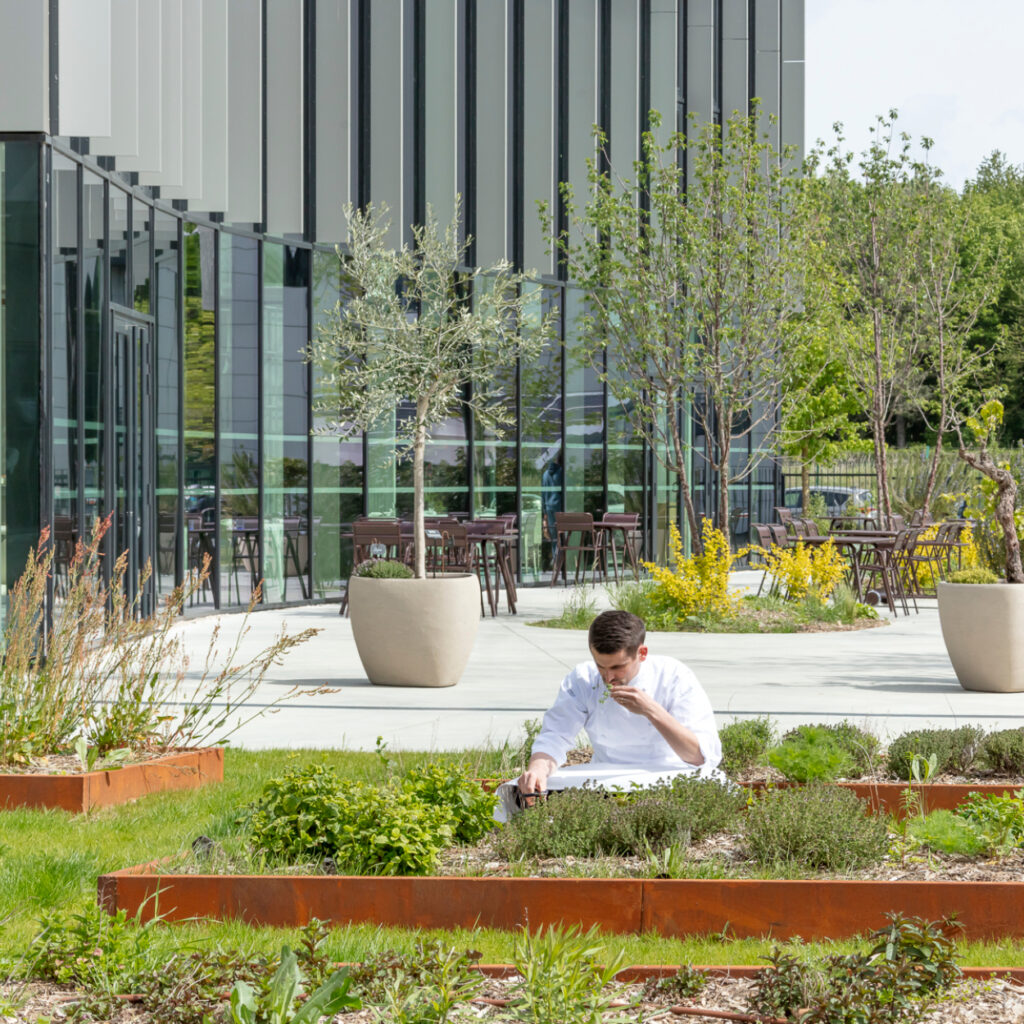FERRANDI Charter

On the occasion of the Summit, students from FERRANDI’s Bachelor’s and Master’s programs have envisioned their charter. A charter for the gastronomy of the future, infused with creativity, joy, inclusivity, equality, rigor, and respect for the well-being of our planet and its inhabitants. We express our deep admiration for this exceptional collaborative work, of undeniable relevance, which undoubtedly will inspire us in the development of our Sustainable Gastronomy Charter.
1. GASTRONOMY IS RESPECTFUL OF THE PLANET
ANTICIPATE the depletion of fossil resources → gas, coal, oil
SAVE energy
USE lids for cooking, avoid leaving appliances on standby, use induction stoves
COOK with wood fire, solar cooking, fermentation techniques
SAVE water
REUSE cooking water, washing water to water the plants
CREATE flavored waters or artisanal beverages → expanded food and beverage pairing
SERVE filtered, carbonated tap water in all restaurants
THINK of restaurant infrastructure in a biomimetic way
Buildings meeting HQE standards inspired by the surrounding nature
Buildings with perfect insulation and high thermal inertia
PREFER products from cultures that preserve the soil
DRAW INSPIRATION from the work of Marc André Selosse
NO LONGER PLOW the soil, which kills all surface life
SOW under mulch
REDUCE the use of non-selective herbicides, fungicides, and insecticides
MOVE AWAY from monoculture and avoid bare soils, shift to permaculture or sustainable agriculture
FEED animals with food scraps → virtuous food cycle
VEGETARIANIZE the offering
REDUCE the animal portion on the plate → especially veal, beef, lamb, swordfish, lobster
STOP the consumption of endangered species (swordfish, bluefin tuna, halibut) or species whose fishing endangers marine ecosystems (deep-sea trawling, FADs)
SUBSTITUTE the animal portion with legumes if taste allows
DEVELOP culinary arts around vegetables → cutting and cooking
USE the entirety of products
“Nothing is lost, nothing is created, everything is transformed” Lavoisier
DRY damaged products with solar dryers
TAKE ADVANTAGE of the characteristics of each part of the cooked products → quince seeds for pectin, meat fat as a flavor enhancer
BETTER TRAIN students in product valorization
STOP teaching vegetable turning techniques that lead to too much waste of the product
PROMOTE local and regional food productions in the restaurant offering while using culinary techniques from around the world → towards “glocal” cuisine (local-global)
PROMOTE food products with PDO, AOC, or PGI designations
LIMIT the use of exotic spices in favor of those from the region, such as thyme, lavender, saffron, calamint, pepper, savory, mustard, juniper berries, etc.
USE alternative sugars in pastry as often as possible → like honey
OFFER fair trade coffee at a minimum, consider offering an alternative to traditional coffee → chicory, barley coffee
LEARN culinary techniques used worldwide to respect the product and improve the organoleptic qualities of food → ikejime, asado, others
REDISCOVER traditional dishes from one’s own region to adopt a flexitarian consumption pattern
VALUE seasonal products
PREFER scallops in season over shrimp, for example
2. GASTRONOMY IS A VEHICLE FOR SOCIAL INCLUSION
RESTORE value to the very principles of hospitality
BECOME a model of compassionate management
RESPECT gender equity
ERADICATE all forms of sexism and violence
GUARANTEE private life time
“BRING dignity through gastronomy” Massimo Bottura
OPEN kitchens to those in need through more social and supportive catering → e.g. Refettorio, République, etc.
RAISE awareness of culinary arts among younger generations from disadvantaged backgrounds
“Stars in the Kitchen” project in Marseille
Thierry Marx’s work → Free school for adults or people in precarious situations
OPEN kitchens to refugees and migrants
e.g. Refugee food, Migrant Cooks
Le Bal Café Recho in which refugees work in the kitchen
REVALUE the table as a place for socialization in the face of the rise of individualized eating
REMIND of the importance of commensality, of “shared cooking”
3. GASTRONOMY IS AN AMBASSADOR FOR HEALTH AND WELL-BEING
Because the link between food and physical and mental health is established
BECOME an advocate for “eating better”
OFFER appropriately portioned, weighed dishes
CHOOSE food products that are beneficial to mental (nuts, polyphenol-rich red fruits) and physical health (fiber)
IMAGINE non-alcoholic food and beverage pairings → acacia champagne or woodruff wine (Benoit d’Onofrio “the soberlier”)
WORK on desserts with reduced sugar
NOURISH the spirit through the restaurant as an experiential discovery venue
OFFER experiential discovery interludes within the restaurant → garden tours, building history
4. CONCLUSION: SLOW PHILOSOPHY
REDEFINE the culinary model that should apply to different stages of the food chain
RESPECT certain agricultural cultures → cereals with longer cultivation times are often more satiating
MEET suppliers, listen to product stories → a source of inspiration and a vector of culinary creativity
COOK, preserve pleasure in practice → a source of well-being within the brigade
ENSURE a better gastronomic experience for the customer to better appreciate and digest
DRAW INSPIRATION from monastic sobriety in culinary practices and in offering the customer experience (hospitality)
OPEN our kitchens to disadvantaged populations
CULTIVATE an edible garden
CELEBRATE sharing and commensality